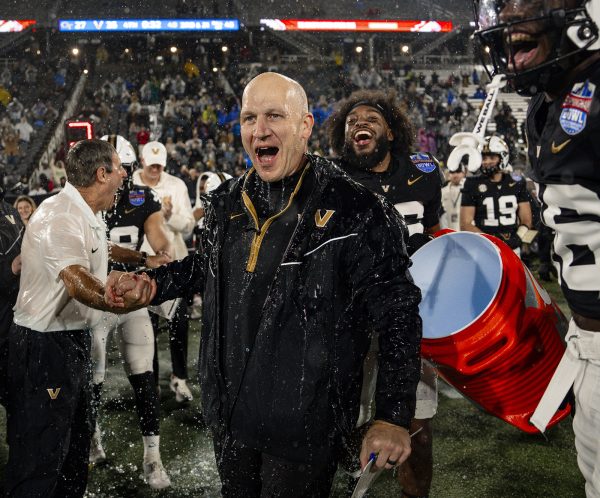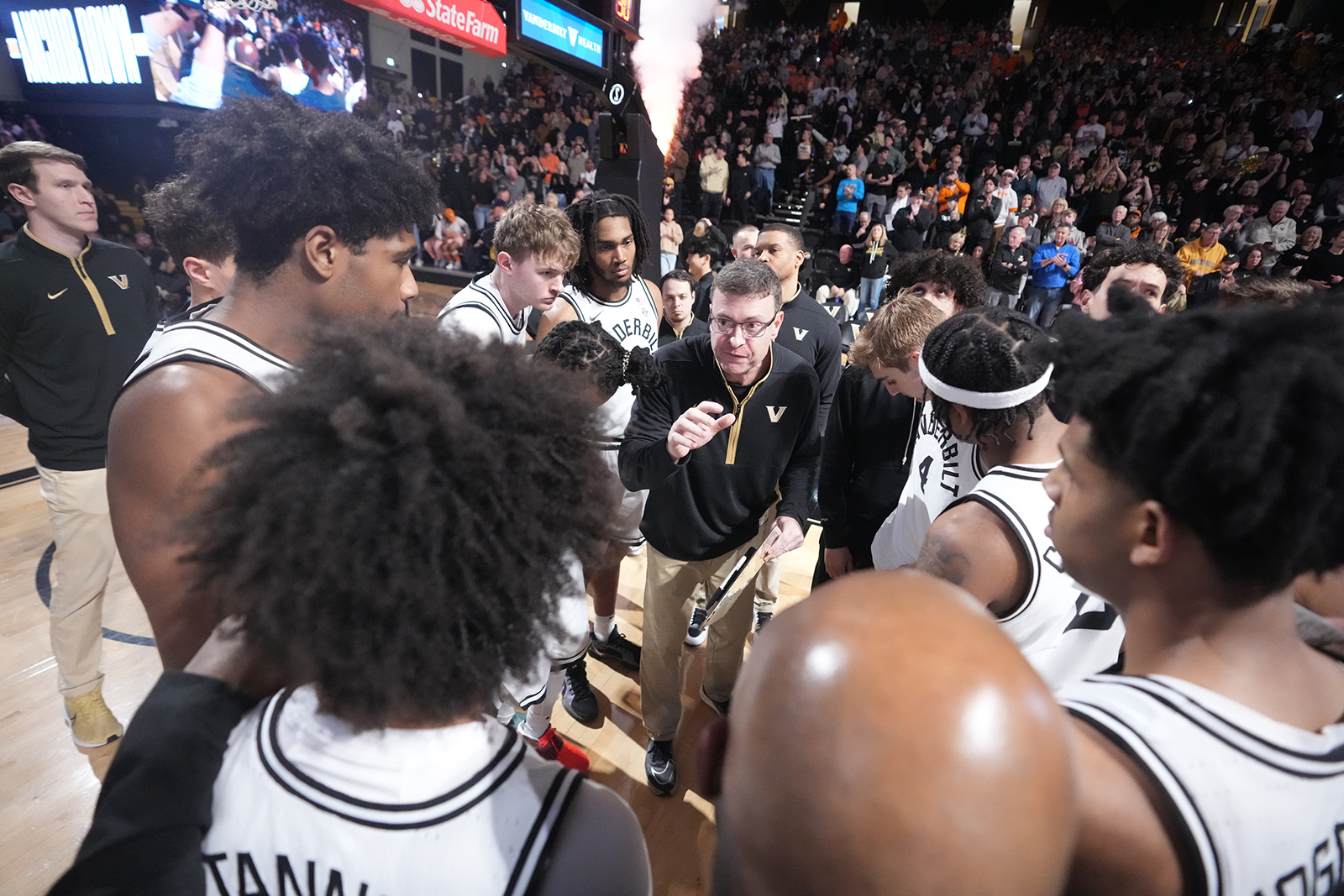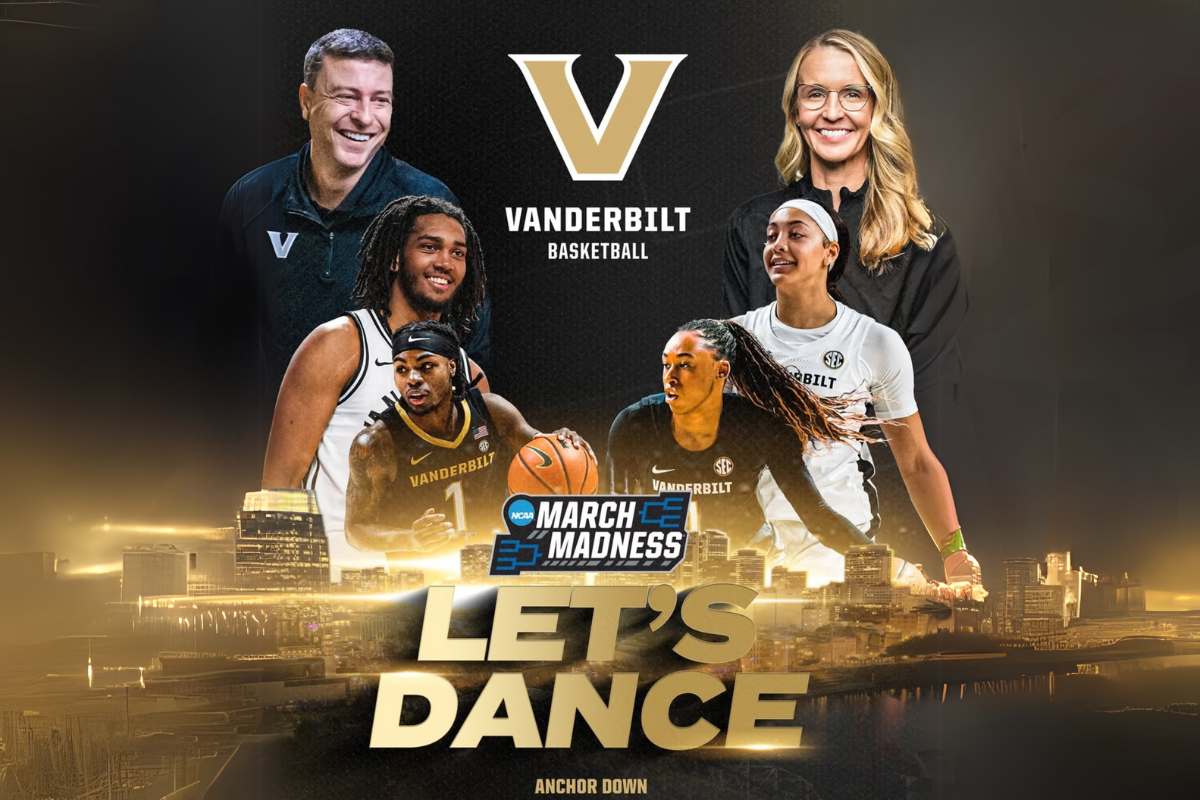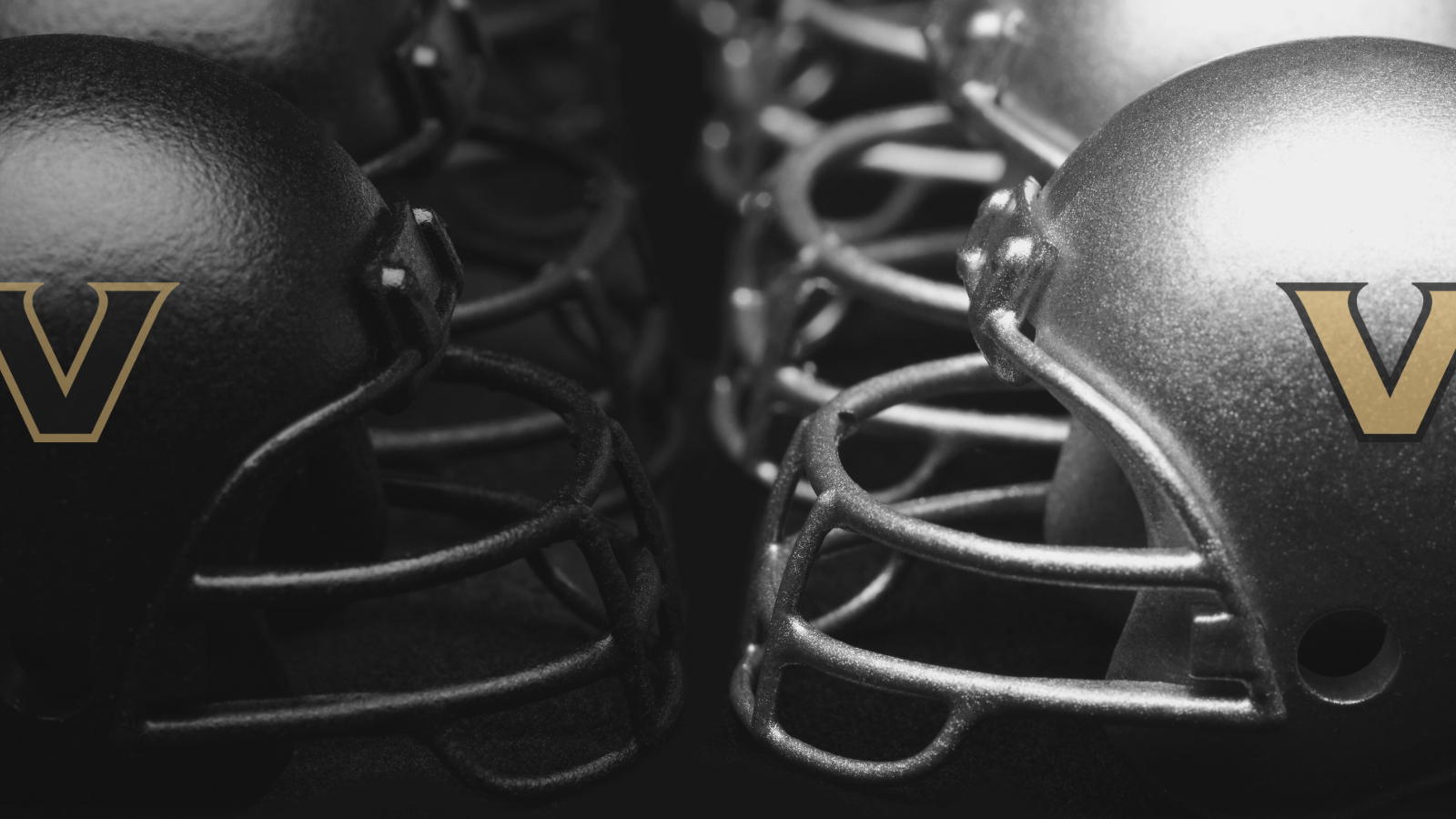By Graham Hays
Two decades before head coach Clark Lea led his alma mater’s football team to a historic win over top-ranked Alabama, a Birmingham Bowl victory over Georgia Tech and Vanderbilt’s first winning season since 2013, he was a transfer student-athlete looking for a place to grow.
After winning an NAIA baseball national championship with Birmingham-Southern in 2001, Lea came home to Nashville and Belmont. A year later, having explored two paths without finding one that felt like his, he set off down a third—coming to Vanderbilt and returning to the football field.

“I felt like it was a story of self-discovery and, honestly, as I processed this, early on I was a little embarrassed,” Lea once told The Hustler. “Why couldn’t I just find a place and make a decision? But I think it was more about understanding … where I wanted to be or what my vision was and what the bigger vision is.”
He wasn’t lost. He was just ahead of his time.
Lea’s path used to be lightly worn in college athletics. Transferring once, let alone multiple times, was a wilderness traversed by stubborn dreamers like Lea—and by those who risked being perceived as misfits and malcontents. Transferring was also difficult, structurally and culturally. But that changed on Oct. 15, 2018, when the NCAA launched the transfer portal. The ensuing chain reaction includes student-athletes monetizing their name, image and likeness and now potentially revenue sharing. Although it was designed as a compliance tool, the portal has become shorthand for an era of profound change.

It is a portal to opportunity: Quarterback Diego Pavia, himself a two-time transfer, helped engineer a season that put Vanderbilt in the national spotlight. A year ago, graduate transfer discus thrower Veronica Fraley became the third Commodore to win an individual NCAA championship; she then competed in the 2024 Olympics. First-year men’s basketball head coach Mark Byington used the portal in reshaping his roster, and his Commodores topped the previous season’s win total before winter break.
It is a portal to challenges: Pavia, Fraley and those who began their college careers elsewhere have brought more than victories to Vanderbilt. They are the 21st-century faces of the time-tested ideals that guided Lea on his journey—the best and brightest choose Vanderbilt because it’s a community that’s committed to helping them
move forward.
“Athletically, we can shine a brighter light on the academic success and the Vanderbilt stories that don’t get told.”
“Vanderbilt already gets worldwide acclaim in academics, research and all these things,” Byington says. “There’s no reason it has to be just that. Athletically, we can shine a brighter light on the academic success and the Vanderbilt stories that don’t get told. You need national teams in football and basketball—the same way Coach Corbin and baseball have already done their thing. You need those teams to foster attention and enthusiasm.
“Whether they’re huge sports fans or not, people will love what they see and be proud that Vanderbilt is in front of the country: ‘That’s my team. That’s where I went to school.’”
PORTAL EXPLAINED
In the early 20th century, even as Vanderbilt led the way in establishing Southern football, college athletics were in flux. Vanderbilt alumnus Grantland Rice helped bring one scandal to light when he wrote about Georgia using ringers—players not enrolled at the university—in a 1907 game against Georgia Tech. The subsequent rules and attitudes that governed transfers for decades were a calcified reaction to those freewheeling early days.
For roughly six decades before the portal’s introduction, would-be transfers had to get permission from their former school and sit out a year of competition (typically more if transferring within the same conference). According to a 2020 Gallup survey, student-athletes transferred at a lower rate than undergraduates in general—even transfers between four-year institutions.
Through the portal, which is part of what the NCAA calls the notification-of-transfer model, student-athletes gained more autonomy. They need only notify a compliance administrator at their school, who then enters their name in the portal. While the name conjures sci-fi images, the portal itself is a transparent central database of student-athletes who are exploring transfers, accessible to coaches and administrators.

Maci Teater, part of the Vanderbilt soccer team that reached the Sweet 16 last fall, transferred to Vanderbilt from North Carolina.
“Basically, you get an email with a link and then you fill out your name, click a button and you’re in the portal,” Teater says. “I remember when I entered, I was like, ‘Is that it?’”
Once entered, student-athletes can communicate with coaches at other schools and negotiate NIL deals with collectives—third-party organizations funded by supporters. Student-athletes must still navigate scholarship and financial aid availability and academic credits and eligibility, but immediate athletic eligibility is no longer an issue. In conjunction with the portal’s introduction, the NCAA altered its rules to allow all student-athletes a one-time transfer without penalty. This was recently extended to multi-time transfers.
A portal entrant isn’t required to transfer, although their original school isn’t required to guarantee any previously established scholarship, financial aid or roster space. And while the increasing number of transfers is most pronounced in football and men’s and women’s basketball, according to NCAA data covering 2021–23, almost every Division I sport experienced a significant increase. It is part of the landscape.
“At heart, most of us got into this for teaching and helping young people,” Byington says. “That hasn’t changed, regardless of transfers, revenue sharing or NIL money. The human relationships haven’t changed. The way the business operates has changed. You’ve got to evolve and make the best of it.”

PORTAL TO COMPETITION
Byington knew he was inheriting a Vanderbilt roster that had been thinned by graduation and transfer. The Commodores began this season with 11 transfers out of 18 student-athletes. Even as he learned his way around a new city, Byington was evaluating 20 or 30 potential recruits a day from the portal.

“You’ve got to figure out if someone is a good enough person, player and student,” Byington says. “If they’re lacking in any of those areas, you’ve got to eliminate them and focus on the ones who are right. From there, you’ve got to break down the basketball and make sure they’re a need positionally, athletically, fitting into our style. It’s not an exact science, and it is very difficult when you have to replace as many players as we had to replace.”
For some, Vanderbilt’s identity is a selling point. Adding a Vanderbilt graduate degree to an undergraduate degree from Cornell—while playing SEC basketball—helped convince first-team All-Ivy point guard Chris Mañon to come to Nashville.

But adding Vanderbilt’s academic rigor on top of basketball development initially gave Jason Edwards pause, Byington recalled. As a person and player, the coaches believed they could build around the junior, who spent one year at Dodge City Community College and one at North Texas. They just needed him to believe Vanderbilt was the place to grow. (NOTE: Following the successful 2023–24 Vanderbilt men’s basketball season, Edwards announced in April that he was transferring to Providence College.)
“He’s an extreme worker,” Byington says. “He absolutely loves basketball. It’s a passion for him. He’s in the gym early mornings, late at night. My favorite thing about him is his energy. He’s never tired. And he plays that way. He plays the game at 100 miles an hour. You’ve got to know who somebody is and what they are and embrace the strength that they have.”
Anchor Impact, the third-party official collective of Vanderbilt Athletics, is supported by fans and empowers student-athletes to explore opportunities for monetizing their name, image and likeness with business, community and charitable organizations. The more Anchor Impact grows, the better Vanderbilt stacks up alongside other top-tier programs in its ability to recruit elite transfers like Edwards.
Anchor Impact is essential. Still, just like in the professional world that college graduates enter, potential compensation is rarely the only variable. The final decision about where to go is still more personal than transactional.
“You’ve got to know who somebody is and what they are and embrace the strength that they have.”
With Edwards, Byington and his staff focused on the holistic development available at Vanderbilt, from helping hone his on-court skills and body for professional basketball to having academic advisers and mentors to prepare him for careers on and off the court. That kind of plan won’t appeal to some. It appealed to Edwards.
Before playing a game for the Commodores, Edwards and fellow transfer AJ Hoggard (who came from Big Ten powerhouse Michigan State) spent a weekend at the NCAA Elite Student-Athlete Symposium in Indianapolis. The three-day event is hosted by NCAA leadership development and basketball enforcement staffs. Invitations are issued after NCAA staff consult with coaches, athletic administrators, professional sports officials and other experts closely linked to the draft process.
Vanderbilt was one of a handful of schools to have two participants, which is indicative of the attention Byington places on personal and professional development.
“I watch my parents go to work every day and do a shift,” Hoggard says. “Basketball is one way for me to take care of what I’ve got to take care of. So I just go out there and try and work at being perfect at it every day. You have to have that mindset.”
PORTAL TO COLLABORATION
CJ Taylor might have followed a path similar to Edwards, Hoggard, Baker or Teater. Among the top-ranked prep football recruits in Tennessee, Taylor was a first-generation college student who didn’t know what to expect out of Vanderbilt. His connection was personal. Barton Simmons, who now is Vanderbilt’s football general manager, had mentored Taylor while working as a recruiting analyst for a media company. He helped Taylor get a foot in the door in the recruiting world. Taylor’s mom taught him that people who treat you with respect when they don’t have to are people worth knowing. Taylor said Simmons treated him like family, and if Simmons believed in Clark Lea—who had yet to coach a game at his alma mater—so could Taylor.
Taylor didn’t play much in his first year. School was a lot. The SEC was a lot. An injury didn’t help. Home for Christmas, even his mom grumbled that he should have played more.

“There’s self-reflection that has to go on,” Taylor says. “You can’t be blind to your ability versus your potential. I knew I had the potential to be where I am now, but you’ve got to be patient.”
By his junior year, he earned fourth-team All-SEC honors. He was one of the nation’s emerging defensive backs. That brought him to a second crossroads with the portal—not in search of more playing time, but knowing that any number of programs would be interested and there were NIL collectives ready to reward
him handsomely.
He stayed at Vanderbilt. Through Anchor Impact, supporters made it tangibly clear that Taylor was a valued part of the community. But staying also came down to the same instincts that brought him to Vanderbilt—he trusted Lea to develop his potential on and off the field. And this past season, he captained the best Vanderbilt team in recent memory.
While being open-minded about the portal is a prerequisite for coaches, Lea, Byington and their peers also hope Vanderbilt is a place student-athletes want to stay. They want to build around people like Taylor, to supplement a solid foundation with transfers.
“There’s self-reflection that has to go on. You can’t be blind to your ability versus your potential. I knew I had the potential to be where I am now, but you’ve got to be patient.”
The final piece of the puzzle is promoting collaboration between old and new. The football team’s success isn’t just the story of a charismatic dual-threat quarterback like Pavia. It’s the story of more than 100 student-athletes coming together at different points of their college journeys and embodying the brotherhood that is one of Lea’s cornerstones.
“If you go to war with somebody that you don’t know, you can’t be confident. If you go to war with somebody that you can’t trust, you’re not confident,” Taylor says. “I think trust and brotherhood are directly correlated to the work that you put in together—the blood, sweat and tears, the times where things aren’t going well and you see people’s true colors.
“When you’re talking about transfers, obviously there are a lot of good players out there. But I think that you have to realize what kind of character they have.”
Today’s world isn’t the one in which Byington played four seasons for UNC-Wilmington. Or the one he coached in for more than 15 years before the portal’s introduction. In that world, changing schools carried a stigma, and transfers were quitters. Part of him still wonders if today’s student-athletes sometimes too readily search for greener grass. But Byington also sees teenagers who are misled or simply don’t yet know what they’re looking for. He understands why they might look around after a year or two and use their accrued wisdom to find a better fit.
In this era, he also understands that success doesn’t start with implementing offenses or running conditioning. It starts with introductions.

“We did so many forced chemistry things in the summer,” Byington says with a slight chuckle. “I wanted them to get to know each other and care about each other. You had to start building in that they’re willing to sacrifice for the team, for each other. That’s not easy when everybody is coming in new and they don’t know each other and they have individual goals. We had to get past the uncomfortable stage and accelerate the caring and chemistry. If you watch us now, I do think that’s a strength of ours.”
PORTAL TO THE FUTURE
According to the Bureau of Labor Statistics, in 2024 the median number of years that wage and salary workers had been with their current employer reached its lowest point in more than two decades. Vanderbilt graduates enter a working world where mobility will be a fact of life throughout their careers.
Though today’s world is more transactional, that doesn’t make a Vanderbilt experience less transformative.
The transfer portal isn’t about rentals or ringers. It’s one more way for the best and brightest—a little older and perhaps a little wiser—to find Vanderbilt, which is a place that for 150 years has been about preparing you for where you’re going.
“Coming to college, in football and with academics, I’ve had to do a lot of stuff that I did not want to do,” Taylor says. “We learn to do hard stuff. And if you keep doing it, you don’t even have to think about it. It comes naturally. Vanderbilt instills in everyone who comes here that if you want to be successful in life, you’ve got to get up and work.”



